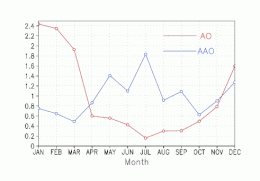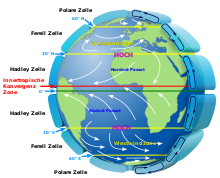Polar vortex
The two polar vortices (polar vortex) over the Arctic and Antarctic, respectively, are large-scale high-altitude lows with a diameter of about less than 1,000 kilometers. Both are essential elements of the atmospheric circulation and belong to the large systems of global teleconnection; the bases of the two polar vortices are located in the middle and upper troposphere and extend up into the stratosphere.
Polar vortices (also polar vortex splits) form as cold air zones due to the negative radiation balance of the polar regions: At altitude, air pressure decreases more markedly poleward than it increases in that direction near the ground. The pressure differences are counteracted by the Coriolis force of circumpolar currents, weakly pronounced near the ground but strongly eastward at altitude: the winds are deflected to the right in the direction of motion, subsequently referred to as polar easterlies; at the North Pole the low thus rotates counterclockwise, at the South Pole clockwise. Polar vortices occur more frequently in the polar winter due to the particularly large temperature differences then; in summer they weaken due to their dependence on the temperature differences between the equator and the poles. The vortices also vary in strength from year to year, with the #AO index indicating the strength of the northern one: When the northern vortex is strong and thus well defined, there is a single vortex with a jet stream and the Arctic air is well "trapped"; when it is weaker, as it generally is, it divides into two or more smaller vortices, the strongest of which circulates near Baffin Island (Canada) and the other over northeastern Siberia.; when it is very weak, the flow of Arctic air becomes more disorganised, and masses of cold Arctic air may move towards the equator, bringing a rapid and sharp fall in temperature in the regions concerned.
The interface between the cold dry air mass of the North Pole and the warmer and moister air masses further south defines the location of the "polar front", it usually has its center at about 60 ° latitude; the "polar cell" marks the underlying main cell of the global climate system.
The trapping of polar air masses in the eye of the polar vortex is one cause of the formation of polar ozone holes, another is the very low temperatures, especially high above the continent of Antarctica.
The dynamics and potential of the polar vortices, the extent of their expression and the patterns of movement possible with them (-> Rossby waves) are calculated and expressed by means of the "AO" (-> "Arctic Oscillation") or "AAO" (-> "Antarctic Oscillation") index; from them, probabilities of corresponding large- and small-scale weather influences can be derived.

Variance of monthly baseline values for A- and AAO (NOAA; 1950-2000)

Location of the northern and southern polar cells as well as other basic elements of global meteorology ("weather kitchen")

Play media file Graphical animation of the North Polar Vortex and Arctic Oscillation between Jan. 24 and 29, 2019: The expansion and protrusion leads to very cold temperatures as far north as the middle of North America
Arctic Oscillation
The Arctic Oscillation (AO, also Northern Hemispheric Annular Mode (NAM)) is an expression of the air pressure opposition between the Arctic and mid-latitudes in the northern hemisphere: The main long-term static position of the northern polar vortex is directly over the Arctic Ocean, with a tendency towards Icelandic lows. However, due to the uneven distribution of warm water surfaces and cold land masses, it often has two displaced centers: one over northeast Siberia and one over northeast Canada - and is destroyed faster than the AAO in the spring. In addition, the vortex can then temporarily split into usually four cores that lie cloverleaf-like around a comparatively mild pole. This typically occurs in a strongly oscillating jet stream and leads to extreme weather conditions in the entire northern hemisphere (polar vortex split).
On average, every two years, the phenomenon of a sudden stratospheric warming occurs in the winter of the northern hemisphere, which is associated with a collapse of the Arctic polar vortex.
→ Main article: Arctic Oscillation
Antarctic Oscillation
The Antarctic Oscillation of the Southern Hemisphere (AAO) is stronger and more persistent than the AO because the "Roaring Forties" are hardly slowed down by land masses; it is found near the Ross Ice Shelf margin near 160 ° west longitude. If the south polar vortex is strong, the mid-latitude westerly winds (winds at the Earth's surface between 30 ° and 60 ° west latitude) also become stronger and more persistent. If this polar vortex is weaker, mid-latitude high pressure zones can push poleward as well as the polar vortex, jet stream, and polar front equatorward: The jet stream "bends" and deviates to the south; this causes cold, dry air to quickly come into contact with the warm, moist air of the mid-latitudes, resulting in a rapid and dramatic change in weather known as a "cold wave".
Search within the encyclopedia